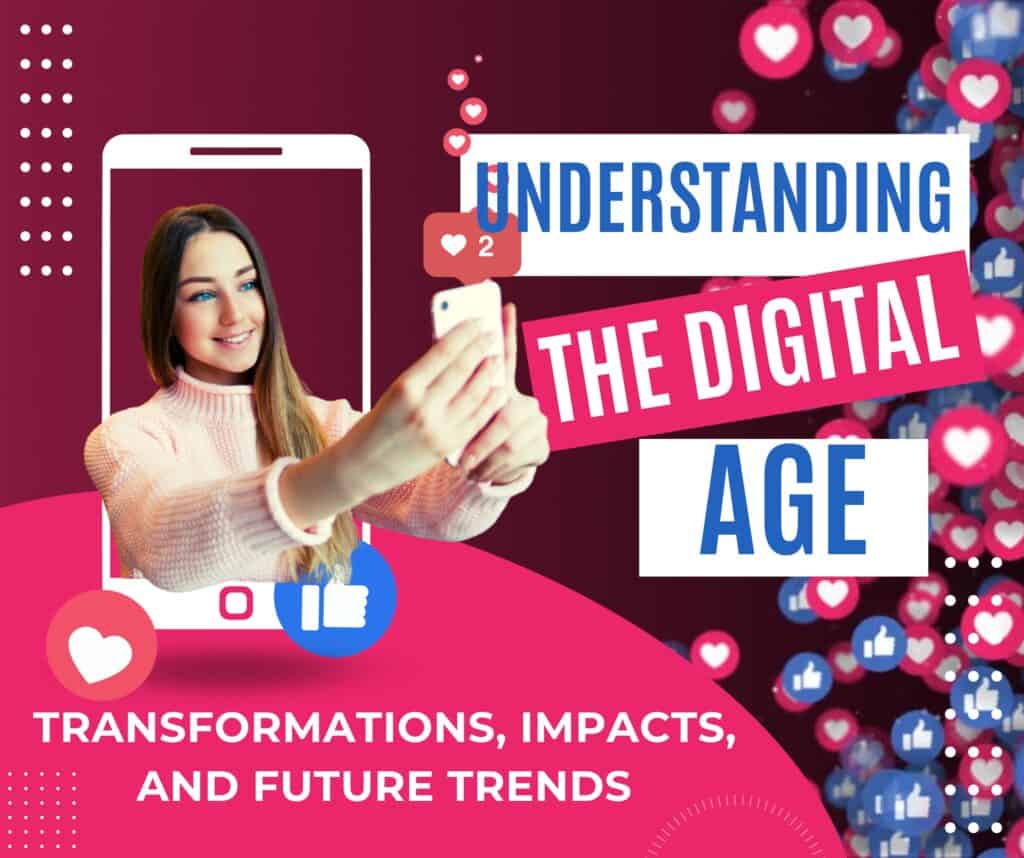The Digital Age, also known as the Information Age or the Computer Age, represents a period in history marked by the rapid shift from traditional industry to an economy based on information technology. This era began in the late 20th century with the advent of computers and the internet, revolutionizing the way we access, share, and process information. The Digital Age has transformed every aspect of human life, from communication and education to business and entertainment. Unlike previous eras where physical goods and manual labor were the primary drivers of economic growth, the Digital Age thrives on the creation, distribution, and manipulation of digital data.
As technology continues to evolve, the influence of the Digital Age only deepens, ushering in new possibilities and challenges. The integration of digital technologies into daily life has led to unprecedented connectivity, enabling instant communication across the globe, access to vast amounts of information, and the automation of complex tasks. The impact of the Digital Age is so profound that it has reshaped societal norms, redefined industries, and altered the global economic landscape.
Disclaimer: This post includes affiliate links, and I may earn a commission if you purchase through them. These links give you access to valuable resources for building a successful online business.
Try Wealthy Affiliate (For Free).
Importance of Understanding the Digital Age in Modern Society
Understanding the Digital Age is crucial for navigating the complexities of modern society. As digital technologies become more embedded in every facet of life, from education and healthcare to commerce and governance, individuals and organizations must adapt to remain relevant and competitive. The Digital Age has created a dynamic environment where the pace of innovation is relentless, and the ability to quickly learn, unlearn, and relearn new skills is essential.
For businesses, understanding the Digital Age means recognizing the importance of digital transformation, which involves leveraging technology to improve processes, enhance customer experiences, and create new business models. Companies that fail to embrace digital transformation risk falling behind their competitors and becoming obsolete.
On a societal level, the Digital Age has brought about significant changes in the way people interact, access information, and participate in civic life. The rise of social media, for instance, has transformed communication, enabling individuals to connect with others across the globe, share ideas, and mobilize around causes. However, it has also raised concerns about privacy, misinformation, and the digital divide—a gap between those who have access to digital technologies and those who do not.
In education, the Digital Age has revolutionized the way knowledge is disseminated and acquired. Online learning platforms, digital resources, and interactive tools have made education more accessible and personalized, allowing learners to study at their own pace and from anywhere in the world.
Moreover, understanding the Digital Age is key to addressing the ethical and societal challenges that come with technological advancement. As we move further into this era, issues such as data privacy, cybersecurity, and the ethical implications of artificial intelligence (AI) and automation become increasingly important. By grasping the nuances of the Digital Age, individuals and societies can make informed decisions that promote equity, security, and sustainable progress.
What is the Digital Age?
Definition and Historical Context
The Digital Age, also known as the Information Age or the Computer Age, is a period in human history marked by the shift from traditional industry to an economy based on information technology. This era is characterized by the widespread use of computers, digital communication, and the internet, which have revolutionized the way information is created, processed, stored, and shared. The Digital Age represents a profound transformation in the way people live, work, and interact with one another, as digital technologies have become integral to almost every aspect of modern life.
Historically, the Digital Age is often considered to have begun in the latter half of the 20th century, with the development of computers and digital communication systems. However, its roots can be traced back to earlier technological advancements, such as the invention of the telegraph and telephone, which laid the groundwork for the digital revolution. The advent of the internet in the 1980s and its subsequent commercialization in the 1990s accelerated the Digital Age, making information more accessible and interconnected than ever before.
Key Milestones Leading to the Digital Age
The journey to the Digital Age is marked by several key milestones that have each played a critical role in shaping the modern world:
- 1940s: The Birth of Computers – The development of the first electronic digital computers, such as the ENIAC (Electronic Numerical Integrator and Computer), marked the beginning of the Digital Age. These early machines, though large and primitive by today’s standards, laid the foundation for modern computing.
- 1960s: The Rise of Semiconductor Technology – The invention of the semiconductor and the microchip revolutionized electronics, enabling the creation of smaller, more powerful, and more affordable computers. This breakthrough was crucial for the mass adoption of digital technology.
- 1969: The Creation of ARPANET – ARPANET, a precursor to the internet, was developed by the U.S. Department of Defense as a means of connecting research institutions. It introduced the concept of packet switching and decentralized communication, which are fundamental to the modern internet.
- 1970s-1980s: The Personal Computer Revolution – The introduction of personal computers (PCs) in the 1970s, with models like the Apple II and IBM PC, brought computing power to homes and small businesses. This democratization of technology was a major milestone in the Digital Age.
- 1989: The Invention of the World Wide Web – Tim Berners-Lee’s creation of the World Wide Web in 1989 transformed the internet from a tool for scientists and researchers into a platform for global communication, commerce, and information exchange.
- 1990s: The Internet Boom – The commercialization of the internet in the 1990s, along with the development of web browsers like Netscape, led to the rapid expansion of the online world. This period saw the birth of e-commerce, email, and the first social networks.
- 2000s: The Rise of Mobile Technology – The proliferation of mobile phones and the advent of smartphones in the 2000s brought the internet into people’s pockets. Mobile technology further accelerated the Digital Age by making digital communication and information accessible anytime, anywhere.
- 2010s: The Age of Social Media and Cloud Computing – The explosion of social media platforms like Facebook, Twitter, and Instagram transformed how people connect and share information. Meanwhile, cloud computing enabled the storage and processing of vast amounts of data, making digital services more scalable and accessible.
The Transition from the Industrial Age to the Digital Age
The transition from the Industrial Age to the Digital Age represents a fundamental shift in the way economies and societies operate. The Industrial Age, which began in the late 18th century, was defined by the rise of manufacturing, mechanization, and the mass production of goods. It was a period of significant technological advancement, driven by the development of steam engines, railways, and factories. The Industrial Age brought about urbanization, the growth of industries, and changes in social structures, laying the groundwork for the modern world.
Start your path to financial freedom today. Click below!
Try Wealthy Affiliate (For Free).
However, the limitations of the Industrial Age became apparent as the demand for information, communication, and services grew. The Industrial Age was largely focused on the production and distribution of physical goods, whereas the Digital Age is centered on the creation, manipulation, and dissemination of digital information. This shift was driven by the realization that information, rather than physical goods, could be the primary driver of economic growth and innovation.
As digital technologies began to emerge, they started to replace traditional industrial processes, leading to the decline of certain industries and the rise of new ones. For example, the introduction of digital automation and robotics in manufacturing has significantly reduced the need for manual labor, while the rise of the internet has given birth to entirely new industries, such as e-commerce, digital marketing, and online services.
The Digital Age has also brought about changes in the way people work and live. The concept of remote work, enabled by digital communication tools, has become increasingly common, challenging traditional notions of the workplace. Additionally, the Digital Age has created new opportunities for innovation and entrepreneurship, allowing individuals and small businesses to reach global audiences with ease.
The Impact of the Digital Age on Society
Communication Revolution
The Rise of Digital Communication Platforms
The Digital Age has brought about a profound transformation in how people communicate. The rise of digital communication platforms has revolutionized the way we connect with others, both personally and professionally. Traditional methods of communication, such as postal mail and landline telephones, have been largely supplanted by digital tools that offer instantaneous, versatile, and often more cost-effective ways to stay in touch.
Key digital communication platforms include email, instant messaging apps, video conferencing tools, and social media. Platforms like Gmail, WhatsApp, and Zoom have become integral to everyday communication, allowing people to exchange messages, make voice and video calls, and collaborate in real-time, regardless of geographic location. This shift has facilitated greater connectivity and efficiency, enabling people to maintain relationships, conduct business, and share information more easily than ever before.
Social Media and Its Influence on Human Interaction
Social media platforms, such as Facebook, Twitter, Instagram, and LinkedIn, have further transformed human interaction by providing spaces for users to connect, share, and engage on a global scale. Social media has created new opportunities for networking, community building, and self-expression, allowing individuals to connect with friends, family, and like-minded individuals around the world.
The influence of social media on human interaction is multifaceted. On one hand, it has democratized communication, giving everyone a voice and the ability to share their perspectives and experiences. This has led to greater social awareness, mobilization around causes, and the creation of virtual communities that transcend physical boundaries.
On the other hand, social media has also introduced challenges, such as the spread of misinformation, the impact on mental health, and the blurring of personal and professional boundaries. The constant exposure to curated content and the pressure to maintain an idealized online presence can contribute to issues like comparison anxiety and diminished face-to-face social skills.
Education and Learning
The Role of Technology in Modern Education
Technology has significantly transformed education and learning in the Digital Age. Digital tools and resources have expanded access to knowledge, making it possible for learners to engage with educational content in new and innovative ways. Interactive whiteboards, multimedia presentations, and educational software have enhanced traditional teaching methods, making lessons more engaging and interactive.
Technology also facilitates personalized learning experiences. Adaptive learning technologies use algorithms to tailor educational content to individual students’ needs, helping them progress at their own pace. This approach allows educators to better address diverse learning styles and needs, improving educational outcomes.
Online Learning Platforms and Digital Literacy
The rise of online learning platforms, such as Coursera, Udemy, and Khan Academy, has revolutionized access to education. These platforms offer a wide range of courses and certifications on various subjects, enabling learners to acquire new skills and knowledge from the comfort of their homes. Online learning has made education more flexible and accessible, breaking down geographical and financial barriers to learning.
Digital literacy has become an essential skill in the Digital Age. As more aspects of life and work move online, the ability to effectively navigate digital tools, evaluate online information, and practice safe online behaviors is crucial. Educational institutions and organizations are increasingly incorporating digital literacy into their curricula and training programs to ensure that individuals are equipped to thrive in a digitally-driven world.
Work and Employment
The Shift to Remote Work and the Gig Economy
The Digital Age has brought about a significant shift in the nature of work and employment. Remote work, facilitated by digital communication tools and collaboration platforms, has become increasingly common. The COVID-19 pandemic accelerated this trend, demonstrating that many jobs can be performed effectively from home or other remote locations. Remote work offers benefits such as increased flexibility, reduced commute times, and the ability to balance work and personal life more effectively.
Alongside remote work, the gig economy has emerged as a prominent feature of the modern job market. The gig economy refers to the rise of short-term, flexible, and freelance work arrangements, enabled by digital platforms like Uber, Airbnb, and Fiverr. This model allows individuals to work on a project-by-project basis, offering greater autonomy and the ability to earn income outside traditional employment structures. However, it also presents challenges, such as job security, inconsistent income, and the lack of benefits typically associated with full-time employment.
Ready to be your own boss? Click to begin
Try Wealthy Affiliate (For Free).
Automation and Its Impact on Jobs
Automation and artificial intelligence (AI) are transforming the workplace by performing tasks that were previously carried out by humans. Technologies such as robotics, machine learning, and process automation are increasing efficiency and productivity in various industries. For example, automated systems in manufacturing can perform repetitive tasks with high precision, while AI-powered tools can analyze vast amounts of data to provide insights and support decision-making.
While automation offers significant advantages, it also raises concerns about its impact on employment. The displacement of certain jobs due to automation can lead to job losses and require workers to adapt by acquiring new skills. This shift necessitates a focus on workforce development and reskilling programs to help individuals transition to new roles and industries. The ability to embrace and leverage automation effectively can ultimately lead to the creation of new job opportunities and the evolution of existing roles.
Digital Age and Business Transformation
E-commerce and Digital Marketing
Growth of Online Businesses and Marketplaces
The Digital Age has fundamentally transformed the business landscape, with e-commerce emerging as a dominant force in the global economy. Online businesses and marketplaces have experienced explosive growth, driven by advancements in digital technology and changing consumer behaviors. Platforms such as Amazon, Alibaba, and eBay have revolutionized retail, making it possible for businesses of all sizes to reach a global audience with minimal overhead costs.
E-commerce has expanded beyond traditional retail, encompassing a wide range of business models, including subscription services, digital products, and dropshipping. The convenience of online shopping, combined with the ability to compare prices and access reviews, has significantly shifted consumer preferences from physical stores to digital platforms.
Additionally, the growth of online marketplaces has democratized entrepreneurship, enabling individuals to start their own businesses with relative ease. Platforms like Etsy and Shopify provide entrepreneurs with the tools and infrastructure needed to set up online stores, manage inventory, and process payments, often without the need for extensive technical expertise or substantial initial investment.
The Importance of Digital Marketing Strategies
In the Digital Age, digital marketing has become a critical component of business success. Unlike traditional marketing, which often relies on print, radio, and television, digital marketing leverages online channels to reach and engage with target audiences. This includes strategies such as search engine optimization (SEO), pay-per-click (PPC) advertising, social media marketing, content marketing, and email marketing.
Digital marketing offers several advantages, including the ability to target specific demographics, track campaign performance in real-time, and adjust strategies based on data-driven insights. SEO helps businesses improve their visibility on search engines like Google, driving organic traffic to their websites. PPC advertising provides a way to attract potential customers through paid ads that appear on search engine results pages and social media platforms.
Social media marketing enables businesses to connect with audiences on platforms such as Facebook, Instagram, and Twitter, fostering brand awareness and customer engagement. Content marketing, which involves creating and sharing valuable content, helps businesses build credibility and attract potential customers. Email marketing remains a powerful tool for nurturing leads and maintaining customer relationships.
Effective digital marketing strategies are essential for businesses to stay competitive in the Digital Age. They help companies reach their target audiences, drive sales, and build brand loyalty in a highly dynamic and ever-evolving digital landscape.
Data and Analytics
The Role of Big Data in Business Decision-Making
Big data refers to the vast amounts of data generated and collected from various sources, including social media, transaction records, and sensors. In the Digital Age, big data has become a crucial asset for businesses, providing valuable insights that drive decision-making and strategy.
The ability to analyze large datasets allows businesses to identify patterns, trends, and correlations that can inform strategic decisions. For example, retailers can use data analytics to understand customer preferences and buying behaviors, enabling them to tailor product offerings and marketing campaigns. Financial institutions leverage big data to detect fraud, manage risk, and optimize investment strategies.
Data-driven decision-making enhances operational efficiency, improves customer experiences, and supports innovation. Companies that effectively harness big data can gain a competitive edge by making informed decisions, predicting market trends, and responding quickly to changes in consumer behavior.
Privacy Concerns and Data Security
With the increased reliance on data comes heightened concerns about privacy and security. Data breaches and cyberattacks pose significant risks, potentially compromising sensitive information and damaging a company’s reputation. Privacy concerns also arise as individuals become more aware of how their personal data is collected, used, and shared.
Regulations such as the General Data Protection Regulation (GDPR) in Europe and the California Consumer Privacy Act (CCPA) in the United States have been introduced to address these concerns and protect consumer privacy. These regulations require businesses to implement robust data protection measures, obtain consent for data collection, and provide transparency about data usage.
Ensuring data security involves adopting best practices such as encryption, secure access controls, and regular security audits. Businesses must also foster a culture of data privacy, educating employees about data protection practices and staying informed about emerging threats and regulatory changes.
Innovation and Entrepreneurship
How the Digital Age Fosters Innovation
The Digital Age has created an environment ripe for innovation, driven by rapid technological advancements and a culture of disruption. Digital technologies, such as cloud computing, artificial intelligence (AI), and blockchain, provide new tools and capabilities that enable businesses to innovate and solve problems in novel ways.
Cloud computing offers scalable infrastructure and services, allowing companies to experiment with new ideas without significant upfront investment. AI and machine learning algorithms enable businesses to automate processes, analyze data, and develop intelligent systems that enhance productivity and customer experiences. Blockchain technology provides secure and transparent methods for conducting transactions and managing digital assets.
The Digital Age has also facilitated innovation by lowering barriers to entry and fostering collaboration. Open-source software, online communities, and collaborative platforms enable individuals and teams to share knowledge, tools, and resources, accelerating the development and implementation of innovative solutions.
Launch your online career now. Click to begin
Try Wealthy Affiliate (For Free).
The Rise of Tech Startups and Digital Entrepreneurs
The Digital Age has given rise to a new generation of tech startups and digital entrepreneurs. The accessibility of digital tools, combined with the availability of venture capital and crowdfunding platforms, has empowered entrepreneurs to launch and scale innovative businesses with relative ease.
Tech startups, driven by disruptive ideas and agile methodologies, are at the forefront of technological advancement. These startups often focus on emerging technologies and business models, challenging established industries and creating new market opportunities. The success of companies like Airbnb, Uber, and Zoom exemplifies the impact of digital entrepreneurship on traditional sectors and global markets.
Digital entrepreneurs leverage the power of the internet to build and grow businesses, often from a small or home-based operation. They use digital marketing, e-commerce platforms, and social media to reach and engage with customers, driving growth and scaling their ventures.
Challenges of the Digital Age
Digital Divide
Access to Technology and the Gap Between Different Demographics
The Digital Age, while offering numerous opportunities, has also highlighted and sometimes exacerbated the digital divide—a gap between those who have access to digital technologies and those who do not. This divide can be observed along various lines, including geographic location, socioeconomic status, and age.
- Geographic Disparities: In many rural and underserved areas, access to high-speed internet and modern digital devices is limited or nonexistent. This lack of access can hinder opportunities for education, economic growth, and social participation, perpetuating cycles of inequality.
- Socioeconomic Differences: Individuals from lower-income backgrounds may struggle to afford the latest technology or reliable internet services. This economic barrier can prevent them from accessing online resources, job opportunities, and essential services that are increasingly digital.
- Age and Digital Literacy: Older adults may face challenges in adapting to new technologies due to limited digital literacy or unfamiliarity with digital tools. This generational gap can affect their ability to participate fully in the digital economy and society.
Efforts to address the digital divide include initiatives to improve internet infrastructure in underserved areas, provide affordable technology options, and offer digital literacy training. Governments, non-profit organizations, and tech companies are working together to promote greater inclusivity and ensure that the benefits of the Digital Age are accessible to all.
Cybersecurity Threats
The Rise of Cybercrime in the Digital Age
As the reliance on digital technologies has grown, so too has the prevalence of cybercrime. The Digital Age has seen an increase in various forms of cyber threats, including hacking, phishing, ransomware attacks, and data breaches.
- Hacking and Data Breaches: Cybercriminals often target organizations and individuals to gain unauthorized access to sensitive information. High-profile data breaches have exposed personal data, financial information, and proprietary business data, leading to significant financial and reputational damage.
- Phishing and Scams: Phishing attacks involve tricking individuals into divulging confidential information, such as passwords or financial details, through deceptive emails or websites. These scams can result in identity theft and financial loss.
- Ransomware: Ransomware attacks encrypt a victim’s data and demand a ransom for its release. These attacks can disrupt business operations, compromise sensitive information, and cause severe financial losses.
Best Practices for Online Safety and Data Protection
To mitigate cybersecurity threats, adopting best practices for online safety and data protection is essential. Key strategies include:
- Use Strong Passwords: Employ complex passwords that are difficult to guess and use different passwords for different accounts. Consider using a password manager to securely store and manage passwords.
- Enable Two-Factor Authentication (2FA): Adding an extra layer of security, such as a text message or authentication app, helps protect accounts from unauthorized access.
- Keep Software Updated: Regularly update software, operating systems, and applications to protect against known vulnerabilities and security flaws.
- Be Cautious with Emails and Links: Avoid clicking on suspicious links or opening attachments from unknown sources. Verify the authenticity of emails before providing any personal information.
- Use Encryption: Encrypt sensitive data to protect it from unauthorized access, especially when transmitting information over the internet.
- Educate and Train: Provide cybersecurity training for employees and individuals to recognize and respond to potential threats and ensure they understand best practices for online safety.
Ethical Considerations
The Ethical Implications of AI and Automation
The rapid advancement of artificial intelligence (AI) and automation brings numerous benefits, but it also raises important ethical considerations. The use of AI in decision-making, surveillance, and automation of tasks presents challenges related to fairness, accountability, and transparency.
- Bias and Fairness: AI systems can inadvertently perpetuate or exacerbate biases present in the data they are trained on. This can lead to discriminatory outcomes in areas such as hiring, lending, and law enforcement. Addressing these biases requires careful design, testing, and ongoing monitoring of AI systems.
- Accountability and Transparency: As AI systems make increasingly complex decisions, it can become challenging to determine who is accountable for their outcomes. Ensuring transparency in AI decision-making processes and holding developers and users accountable is crucial for maintaining trust and ethical standards.
- Privacy Concerns: AI and automation often involve the collection and analysis of vast amounts of personal data. Ensuring that this data is used responsibly and that individuals’ privacy is protected is a key ethical consideration.
Balancing Technological Advancement with Human Values
As technology continues to advance, it is essential to balance innovation with human values and ethical considerations. This involves:
- Promoting Ethical Standards: Developing and adhering to ethical guidelines and standards for technology use ensures that advancements benefit society while minimizing harm.
- Engaging Stakeholders: Involving diverse stakeholders, including ethicists, policymakers, and the public, in discussions about technology’s impact helps address potential concerns and create more equitable solutions.
- Fostering a Human-Centric Approach: Designing technologies with a focus on enhancing human well-being, respecting privacy, and promoting fairness helps ensure that technological progress aligns with societal values.
Ready to start making money online? Click below!
Try Wealthy Affiliate (For Free).
The Future of the Digital Age
Emerging Technologies
The Impact of AI, IoT, and Blockchain on the Future
The future of the Digital Age will be significantly shaped by emerging technologies such as artificial intelligence (AI), the Internet of Things (IoT), and blockchain. These technologies are expected to drive innovation, transform industries, and influence various aspects of daily life.
- Artificial Intelligence (AI): AI is poised to revolutionize numerous fields by enabling machines to perform tasks that typically require human intelligence. Advances in AI, including machine learning and natural language processing, will lead to more sophisticated and autonomous systems. AI has the potential to enhance personalized experiences, optimize business operations, and solve complex problems. For example, AI-powered healthcare solutions can improve diagnostic accuracy and patient care, while AI-driven automation can streamline manufacturing processes and enhance productivity.
- Internet of Things (IoT): IoT refers to the network of interconnected devices that communicate and exchange data over the internet. As IoT technology evolves, it will enable greater integration and automation across various sectors. Smart homes, for instance, will feature interconnected devices that enhance convenience, security, and energy efficiency. In industrial settings, IoT will facilitate predictive maintenance, real-time monitoring, and process optimization. The proliferation of IoT devices will lead to more data collection and analysis, driving innovation and enabling smarter decision-making.
- Blockchain: Blockchain technology provides a decentralized and secure method for recording transactions and managing digital assets. It is best known for its role in cryptocurrencies like Bitcoin, but its applications extend beyond digital currencies. Blockchain can enhance transparency, traceability, and security in various domains, including supply chain management, financial services, and voting systems. The use of smart contracts on blockchain platforms can automate and enforce contractual agreements, reducing the need for intermediaries and increasing efficiency.
Predictions for the Next Phase of Digital Transformation
As we look ahead, several key trends and predictions are likely to shape the next phase of digital transformation:
- Increased Integration of AI and Automation: AI and automation will continue to advance, leading to more intelligent and autonomous systems. Businesses will increasingly adopt AI-driven solutions to enhance efficiency, customer experience, and decision-making. Automation will become more prevalent in both industrial and service sectors, transforming traditional workflows and creating new opportunities for innovation.
- Expansion of Smart Technologies: The IoT ecosystem will expand, leading to a proliferation of smart devices and interconnected systems. This expansion will drive the development of smart cities, where infrastructure, transportation, and public services are optimized through data-driven insights. The integration of IoT with other technologies, such as AI and 5G, will enable more sophisticated and responsive systems.
- Growth of Decentralized Systems: Blockchain technology will gain traction in various sectors, leading to the development of decentralized applications and platforms. This growth will enhance transparency, security, and efficiency in areas such as supply chain management, financial transactions, and digital identity verification.
- Advancements in Quantum Computing: Quantum computing, which leverages the principles of quantum mechanics to perform complex computations, has the potential to revolutionize fields such as cryptography, optimization, and drug discovery. As quantum computing technology matures, it will unlock new possibilities and address challenges that are currently beyond the capabilities of classical computers.
Preparing for the Future
Skills Needed to Thrive in the Digital Age
To navigate the future of the Digital Age successfully, individuals and organizations must develop and cultivate a range of skills that align with evolving technological trends:
- Technical Skills: Proficiency in digital technologies, such as AI, data analytics, and cybersecurity, will be essential. Understanding how to leverage these technologies and apply them to various contexts will be a valuable asset.
- Digital Literacy: Competence in using digital tools, platforms, and software is crucial. Digital literacy includes the ability to effectively navigate online environments, evaluate information sources, and utilize digital resources for personal and professional purposes.
- Adaptability and Problem-Solving: The rapid pace of technological change requires individuals to be adaptable and proactive in addressing new challenges. Problem-solving skills will be essential for identifying innovative solutions and adapting to evolving circumstances.
- Collaboration and Communication: As technology increasingly facilitates remote work and virtual collaboration, strong communication and teamwork skills will remain vital. Being able to collaborate effectively with diverse teams and communicate clearly across digital platforms will contribute to success in the digital workplace.
The Importance of Continuous Learning and Adaptation
In the Digital Age, continuous learning and adaptation are key to staying relevant and thriving in a rapidly changing environment. Technology and industry trends are constantly evolving, making it important for individuals and organizations to stay informed and proactively seek opportunities for growth:
- Embrace Lifelong Learning: Commit to ongoing education and skill development to keep up with technological advancements and industry changes. This may include pursuing formal education, participating in professional development programs, or engaging in self-directed learning.
- Stay Informed: Keep abreast of the latest trends, innovations, and best practices in your field. Following industry news, attending conferences, and joining professional networks can help you stay updated and informed.
- Foster a Growth Mindset: Adopt a growth mindset that values curiosity, experimentation, and resilience. Embrace challenges as opportunities for learning and development, and be open to exploring new technologies and approaches.
- Encourage Organizational Learning: Organizations should foster a culture of continuous learning by providing employees with access to training resources, promoting knowledge sharing, and encouraging innovation. This approach will help organizations remain competitive and adapt to evolving market demands.
Conclusion
Recap of the Key Points Discussed
Throughout this article, we’ve explored the multifaceted landscape of the Digital Age, highlighting its transformative impact on various aspects of society, business, and technology. Here’s a recap of the key points discussed:
- What is the Digital Age? We defined the Digital Age as the era characterized by rapid technological advancements and the pervasive influence of digital technologies. We examined the historical context and key milestones that have led to this age, including the transition from the Industrial Age to a digital-centric world.
- The Impact of the Digital Age on Society: We discussed how digital technologies have revolutionized communication, education, and work. The rise of digital communication platforms and social media has reshaped human interaction, while technology in education has expanded access to learning resources. The shift to remote work and automation has redefined employment landscapes and job roles.
- Digital Age and Business Transformation: We examined how e-commerce and digital marketing have transformed business operations and customer engagement. The role of big data and analytics in decision-making was highlighted, along with the rise of innovation and entrepreneurship fueled by digital advancements.
- Challenges of the Digital Age: We addressed key challenges such as the digital divide, which highlights disparities in access to technology; cybersecurity threats, which pose risks to data and privacy; and ethical considerations related to AI and automation, including issues of bias and accountability.
- The Future of the Digital Age: We looked at emerging technologies like AI, IoT, and blockchain and their potential impact on the future. Predictions for the next phase of digital transformation were discussed, emphasizing the importance of staying prepared by developing relevant skills and embracing continuous learning.
Want to work for yourself? Click to begin
Try Wealthy Affiliate (For Free).
The Ongoing Evolution of the Digital Age
The Digital Age is a dynamic and ever-evolving landscape. As technology continues to advance, new opportunities and challenges will emerge, shaping how we live, work, and interact. The continuous evolution of digital technologies will drive further innovations and disruptions, influencing every aspect of our daily lives and the global economy.
The pace of change in the Digital Age necessitates a proactive approach to adaptation. Businesses, individuals, and institutions must remain agile and forward-thinking to navigate this evolving landscape effectively. Staying informed about emerging trends, investing in digital skills, and embracing new technologies will be crucial for success in an increasingly digital world.
Final Thoughts on Embracing and Navigating the Digital Age
Embracing the Digital Age requires an open mindset and a willingness to adapt to new ways of thinking and operating. The benefits of digital technologies are vast, offering opportunities for growth, innovation, and enhanced connectivity. However, it is equally important to address the challenges and ethical considerations that accompany technological advancements.
By staying engaged with ongoing developments, investing in continuous learning, and adopting best practices for digital engagement and security, we can navigate the Digital Age with confidence and resilience. Embracing the potential of digital technologies while balancing them with human values and ethical considerations will help ensure that the Digital Age contributes positively to society and drives progress for all.
As we move forward, let us approach the Digital Age with curiosity, adaptability, and a commitment to leveraging its potential for creating a more connected, informed, and innovative world.
any experiences or insights to share about navigating the world of digital technology? If you have questions or thoughts on any of the topics we’ve discussed, feel free to drop them in the comments below.
Your feedback and stories can contribute to a richer understanding of the Digital Age and help others as they navigate this exciting and ever-evolving landscape. Let’s continue the conversation and explore how we can all embrace and thrive in the Digital Age together!







